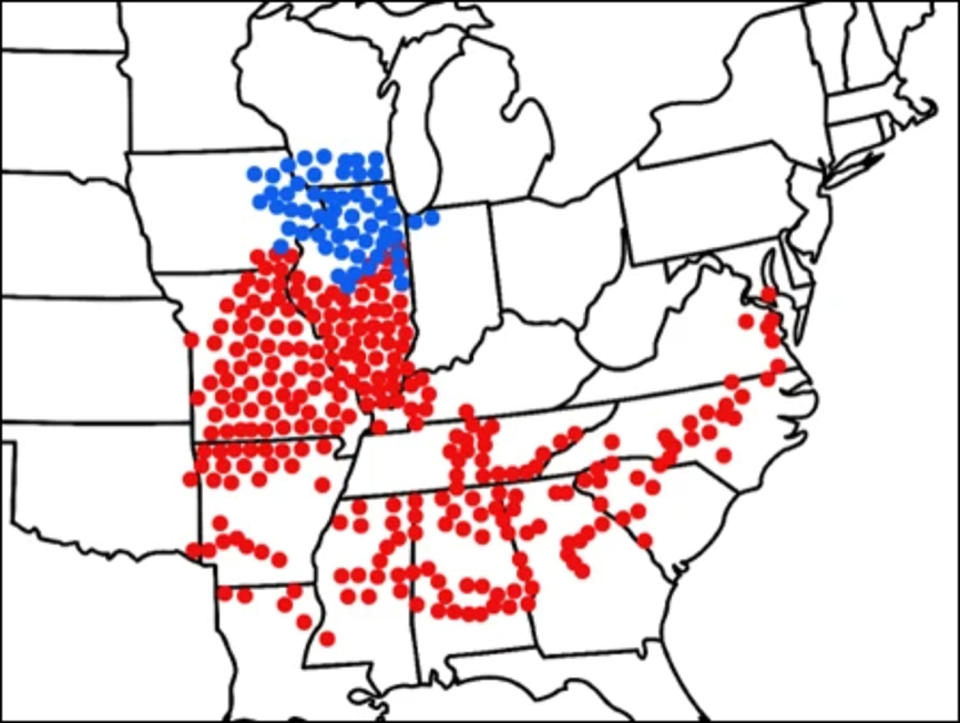[ad_1]
Tens of billions of pesky cicadas are set to emerge from the ground in the coming weeks in a rare synchronized event that last occurred 221 years ago.
The winged insects are expected to appear throughout the Midwest and Southeast starting in early May, in 2019. Double appearance of two different broods of periodical cicada. These insects spend a set number of years underground before emerging to the surface to engage in noisy mating rituals.
This year's emergence is expected to be unusually large, with some experts estimating that more than a trillion cicadas could cover parts of the country where the two broods overlap.
Cicadas are harmless to humansAlthough some people find the sheer number of insects and loud mating songs a nuisance.
For insect enthusiasts, it's a once-in-a-lifetime opportunity to experience cicada broods together, since it last happened in 1803, when Thomas Jefferson was president.
“It's something no one alive today has ever seen and no one alive today will ever see again,” said Jim Luderman, collections assistant in the entomology department at the Field Museum in Chicago. “For entomologists, it's a really big deal.”
This spring's emergence will feature Brood XIII and Brood XIX cicadas. The first group lives on a 17-year cycle and typically appears in the Midwest, mostly in Illinois, but also in parts of Iowa, Wisconsin and Indiana.
Brood 19 cicadas, meanwhile, live on a 13-year cycle and appear over a much larger geographic area that includes Illinois, Missouri, Louisiana, North Carolina, Virginia and Maryland.


Seven broods of periodical cicadas make their home in North America, and depending on the species, they emerge either every 13 or 17 years. Sometimes a 13-year-old brood and a 17-year-old brood emerge at the same time, but each specific pair sees their cycles align only once every 221 years.
This year's event is unusual because these particular broods coincide and also because they are adjacent to each other, with a narrow area of geographic overlap in central Illinois.
“There aren't many places in the country where two completely different broods overlap,” said Daniel Young, a professor of entomology at the University of Wisconsin-Madison and director of the school's insect research group.
Thousands of cicada species can be found around the world, but periodical cicadas are special because they spend most of their lives underground, feeding on tree roots. After 13 or 17 years, depending on the brood, the insects emerge to the surface to begin a frantic, month-long search for a mate.
Louderman said he hasn't seen any reports yet of early cicada sightings. The insects usually emerge from underground once soil temperatures reach about 64 degrees Fahrenheit.
Some may start appearing in early or mid-May, Louderman said. This should continue into June as conditions warm. Once the insects are out in full force, he and his colleagues will travel throughout Illinois collecting specimens for the Field Museum's collection.
Cicadas are perhaps best known for the noise they make when above ground. It's hard to ignore the insects' mating song, a high-pitched buzz that can reach 100 decibels.
“There are just so many of them The noise is almost deafeningLouderman said. “It's as if 1,000 chainsaws are going off and they're all being used at the same time.”
The insects have a chaotic few weeks to find a mate and lay eggs before they die. After that, people are likely to see a large number of insect corpses scattered on the ground.
“They're literally paving the sidewalks and streets, it's crazy,” Louderman said. “Some people are afraid of it.”
Cicadas don't bite, Louderman added.
He describes himself as a “lifelong cicada lover” and said his passion came after his early exposure to the insects.
“There was a periodic appearance of cicadas when I was 8 years old, which got me hooked on insects and entomology,” Louderman said.
In the same way that a total solar eclipse has raised eyebrows for many this spring, perhaps some young people will find fascination with the appearance of cicadas and decide to pursue his field of study, he said.
At the University of Wisconsin-Madison, researchers plan to track where cicadas have been spotted in order to map their range. Young encourages others to get involved in the mission as well.
People in the Midwest and Southeast can take photos of cicadas in their area and report sightings via an app called Cicada Safari Or on sites like Bugsinourbackyard.org or Bugguide.net.
Young said he hopes people will take the opportunity to experience this rare and important event, especially in parts of Illinois where the two cicada broods overlap.
“Not many people in human history will be in a place to witness that,” he said. “A lot of people might find it very unpalatable, but it is a very amazing thing.”
This article was originally published on NBCNews.com
[ad_2]
Source

